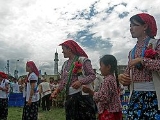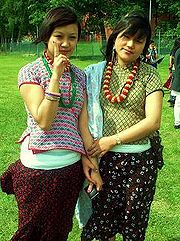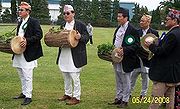
Sakela
Encyclopedia
Sakela is the main festival of Kirat which is celebrated twice a year distinguished by two names Ubhauli and Udhauli. Sakela Ubhauli is celebrated during Baisakh Purnima (full moon day in the month of Baishak) and Sakela Udhauli is celebrated during the full moon day in the month of Mangshir.
of the dance while the other dancers imitate them. The sili, style of the dance moves, reflects the different aspects of human life and our relationship with nature.
The ritual starts with the chula puja, worship of chula
, at home by the kirat priest nakchhong
. After completion of the chula puja, nakchhong
performs a sacrificial rite (usually with chicken) over a sacred place known as Sakela Than, which is usually under a sacred tree.
The nakchhong
signals the completion of rituals by starting the Sakela dance by him/herself and the actual group Sakela dance commences then. All dancers form a large circle and dance joyously around it. The beating of the Dhol(Drum) and the "Jhyamta" accompany the different silies guided by the Silimangpa and the Silimangma.
Among Kirats Rais
, Yakkha
and Sunuwar celebrate this festival,whereas Limbu
's have their own Chasok Tangnam
.
 According to the Kirat holy book, Mundhum
According to the Kirat holy book, Mundhum
, a year is divided into two phases: Ubhauli (Going up) and Udhauli (Going down). It is generally accepted that the naming comes from the migration pattern of birds. During the start of the winter season in Mangshir, the birds migrate downward toward the warmer Terrain belt, and thus this phase of the year is known as Udhauli,meaning Downward. Likewise, during the rise of the summer season, the birds migrate upward to the cooler Hilly region, and therefore this latter phase is known as Ubhauli.
Kirats believe in Shamanism
and are worshipers of Mother Nature. The Sakela celebration is a prayer to Mother Nature for healthy crops and protection from natural calamities. Therefore, the festival is also known as "Bhumi Puja". Starting on Baisakh Purnima, Sakela Ubhauli is celebrated for 15 days in Baisakh (April/May) marking the beginning of the farming year.
Similarly, the celebration of Sakela Udhauli during Mangshir (November/December)which is harvest season, is their way of giving thanks to nature for providing them with a good harvest.
 The celebration of Sakela is connected to many myths. According to Kirat Mythology, it is said that before the marriage of Sumnima and Paruhang, Paruhang used to live in the heavens .One day, he saw beautiful Sumnima on earth and fell in love with her. He made her a beautiful comb and sent it to Sumnima who wished to wed him.
The celebration of Sakela is connected to many myths. According to Kirat Mythology, it is said that before the marriage of Sumnima and Paruhang, Paruhang used to live in the heavens .One day, he saw beautiful Sumnima on earth and fell in love with her. He made her a beautiful comb and sent it to Sumnima who wished to wed him.
Four children were born of them after marriage. But Paruhang left Sumnima in a hut on the bank of the Dudhkoshi river and did not return for a long time. One day, Sumnima saw a creeper growing on a rock while she was in search of food for her children. She tasted the creeper and found it was full of power and happiness. She brought the creeper and made a Buti, an intoxicating religious garland, out of it. The Buti inspired everybody who saw it to speak the truth about her/his life.
One day Paruhang returned suddenly. He tried to counsel with the angry Sumnima. She then gave him the Buti. This immediately made him glad and he started to tell her about what he had done. He had spent the time looking at Heaven and Earth from atop Chomolongma (Mt. Everest). He also told her that he had meditated and visited the entire universe. Paruhang promised not to leave her again, which made Sumnima dance with joy. It is believed that her joyous dance is the 'Sakela Dance'. And so tradition has it that young boys and girls comes to participate in Sakela in order to meet each other and find their love.
According to the Mundhum, Rai (Kirant) came out of the Khuwalung (sea or big river) meaning the Ganga river. Then followed the small river or the Saptakoshi. On their journey they first met with a duck, (hans) then the river bird (dhobi chara), Black bird (kalchuda), deer (mirga), (thar) musk deer (Kasturi) etc. They journeyed through the Arun valley, Dudh Koshi valley, Sun Koshi valley, Tama Koshi valley and finally settled down in the Bhote Koshi valley. The Nakchhong, or the leader of the Sakela, narrates this Mundhum (history). When he carries out the ritual in Sakela he tells the Mundhum (story) of how our ancestor came out of the Khuwalung and met a duck and at the same time he dances in the pattern (sili) of a duck, likewise when he talks about the Dhobi Chara he dances in the pattern of the Dhobi Chara. This is the Kirat way of relating the story (Mundhum) verbally and through acting.
, United Kingdom
, Australia
and United States
. But, the real flavour of the dance can only be seen in the eastern hills of Nepal. This interest in Sakela has helped to spread the Nepali culture all across the world.
Characteristics
The main characteristic of this festival is the Sakela dance performed by large groups of Kirats wearing their traditional attire. People from all ages dance together in a large circle. There are male and female leaders in each circle known as Silimangpa and Silimangma respectively. These two people control the siliSili
Sili is a village on the south side of Savai'i island in Samoa. Sili is situated inland, unlike most villages in Samoa which are settlements by the sea. The village lies within the electoral constituency of Palauli....
of the dance while the other dancers imitate them. The sili, style of the dance moves, reflects the different aspects of human life and our relationship with nature.
The ritual starts with the chula puja, worship of chula
Kitchen
A kitchen is a room or part of a room used for cooking and food preparation.In the West, a modern residential kitchen is typically equipped with a stove, a sink with hot and cold running water, a refrigerator and kitchen cabinets arranged according to a modular design. Many households have a...
, at home by the kirat priest nakchhong
Nakchhong
Nakchhong is the Kirat priest who performs different Kirat rituals. Some of the materials generally required by nakchong are listed below.*Aduwa *Pokhemma*Tupla...
. After completion of the chula puja, nakchhong
Nakchhong
Nakchhong is the Kirat priest who performs different Kirat rituals. Some of the materials generally required by nakchong are listed below.*Aduwa *Pokhemma*Tupla...
performs a sacrificial rite (usually with chicken) over a sacred place known as Sakela Than, which is usually under a sacred tree.
The nakchhong
Nakchhong
Nakchhong is the Kirat priest who performs different Kirat rituals. Some of the materials generally required by nakchong are listed below.*Aduwa *Pokhemma*Tupla...
signals the completion of rituals by starting the Sakela dance by him/herself and the actual group Sakela dance commences then. All dancers form a large circle and dance joyously around it. The beating of the Dhol(Drum) and the "Jhyamta" accompany the different silies guided by the Silimangpa and the Silimangma.
Among Kirats Rais
Rais
Raees, Raeesha, is a title used by the rulers of Muslim states in the Middle East and South Asia. It is translated as president in Arabic and wealthy in Persian...
, Yakkha
Yakkha
Yakkha is an indigenous ethnic group of Nepal . It is one of the progenies of Nepal's prehistoric Kirat dynasty of around 100 BC.-Etymology:...
and Sunuwar celebrate this festival,whereas Limbu
Limbu people
The Yakthung or Limbu tribes and clans belong to the Kirati nation or to the Kirat confederation.They are indigenous to the hill and mountainous regions of east Nepal between the Arun and Mechi rivers to as far as Southern Tibet, Bhutan and Sikkim....
's have their own Chasok Tangnam
Chasok Tangnam
Chasok Tangnam is the most important of Kirat Limbu festivals. This festival falls on a full moon day of the month of Senchengla or the Mangsir month of Nepali calendar. "Tangnam" simply means festival in Limbu language. Along with the resurgence of Limbu identity, culture and nationalism, Limbus...
.
Significance

Mundhum
Mundhum is the ancient religious scripture and folk literature of the Kirat people of Nepal, central to Kirat Mundhum, the ancient, indigenous religion of Nepal. Mundhum means "the power of great strength" in the Kiranti languages...
, a year is divided into two phases: Ubhauli (Going up) and Udhauli (Going down). It is generally accepted that the naming comes from the migration pattern of birds. During the start of the winter season in Mangshir, the birds migrate downward toward the warmer Terrain belt, and thus this phase of the year is known as Udhauli,meaning Downward. Likewise, during the rise of the summer season, the birds migrate upward to the cooler Hilly region, and therefore this latter phase is known as Ubhauli.
Kirats believe in Shamanism
Shamanism
Shamanism is an anthropological term referencing a range of beliefs and practices regarding communication with the spiritual world. To quote Eliade: "A first definition of this complex phenomenon, and perhaps the least hazardous, will be: shamanism = technique of ecstasy." Shamanism encompasses the...
and are worshipers of Mother Nature. The Sakela celebration is a prayer to Mother Nature for healthy crops and protection from natural calamities. Therefore, the festival is also known as "Bhumi Puja". Starting on Baisakh Purnima, Sakela Ubhauli is celebrated for 15 days in Baisakh (April/May) marking the beginning of the farming year.
Similarly, the celebration of Sakela Udhauli during Mangshir (November/December)which is harvest season, is their way of giving thanks to nature for providing them with a good harvest.
Legend

Four children were born of them after marriage. But Paruhang left Sumnima in a hut on the bank of the Dudhkoshi river and did not return for a long time. One day, Sumnima saw a creeper growing on a rock while she was in search of food for her children. She tasted the creeper and found it was full of power and happiness. She brought the creeper and made a Buti, an intoxicating religious garland, out of it. The Buti inspired everybody who saw it to speak the truth about her/his life.
One day Paruhang returned suddenly. He tried to counsel with the angry Sumnima. She then gave him the Buti. This immediately made him glad and he started to tell her about what he had done. He had spent the time looking at Heaven and Earth from atop Chomolongma (Mt. Everest). He also told her that he had meditated and visited the entire universe. Paruhang promised not to leave her again, which made Sumnima dance with joy. It is believed that her joyous dance is the 'Sakela Dance'. And so tradition has it that young boys and girls comes to participate in Sakela in order to meet each other and find their love.
According to the Mundhum, Rai (Kirant) came out of the Khuwalung (sea or big river) meaning the Ganga river. Then followed the small river or the Saptakoshi. On their journey they first met with a duck, (hans) then the river bird (dhobi chara), Black bird (kalchuda), deer (mirga), (thar) musk deer (Kasturi) etc. They journeyed through the Arun valley, Dudh Koshi valley, Sun Koshi valley, Tama Koshi valley and finally settled down in the Bhote Koshi valley. The Nakchhong, or the leader of the Sakela, narrates this Mundhum (history). When he carries out the ritual in Sakela he tells the Mundhum (story) of how our ancestor came out of the Khuwalung and met a duck and at the same time he dances in the pattern (sili) of a duck, likewise when he talks about the Dhobi Chara he dances in the pattern of the Dhobi Chara. This is the Kirat way of relating the story (Mundhum) verbally and through acting.
Current Trend
The Sakela dance has become very popular in the cities of Nepal particularly among the younger generation. Kirat Rai celebrating this festival widely outside of Nepal as well specially in Sikim, Hong KongHong Kong
Hong Kong is one of two Special Administrative Regions of the People's Republic of China , the other being Macau. A city-state situated on China's south coast and enclosed by the Pearl River Delta and South China Sea, it is renowned for its expansive skyline and deep natural harbour...
, United Kingdom
United Kingdom
The United Kingdom of Great Britain and Northern IrelandIn the United Kingdom and Dependencies, other languages have been officially recognised as legitimate autochthonous languages under the European Charter for Regional or Minority Languages...
, Australia
Australia
Australia , officially the Commonwealth of Australia, is a country in the Southern Hemisphere comprising the mainland of the Australian continent, the island of Tasmania, and numerous smaller islands in the Indian and Pacific Oceans. It is the world's sixth-largest country by total area...
and United States
United States
The United States of America is a federal constitutional republic comprising fifty states and a federal district...
. But, the real flavour of the dance can only be seen in the eastern hills of Nepal. This interest in Sakela has helped to spread the Nepali culture all across the world.

